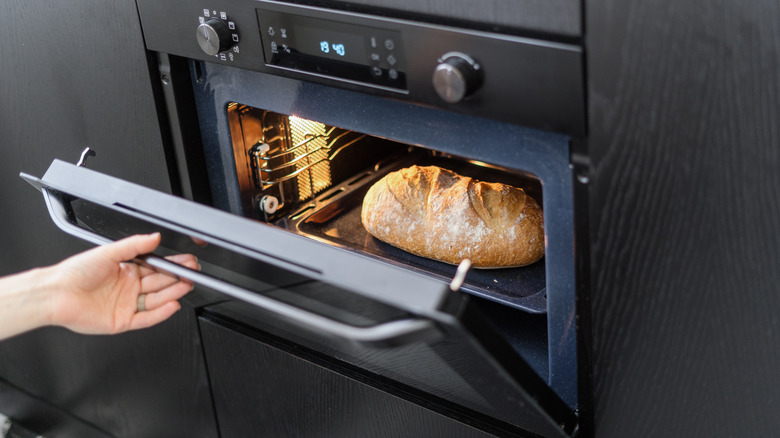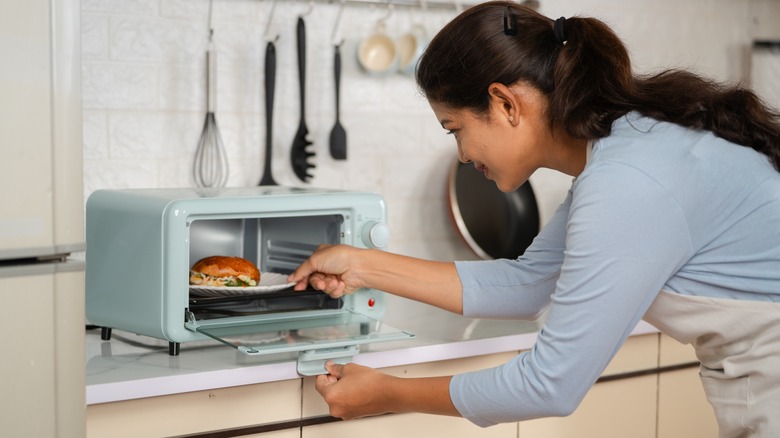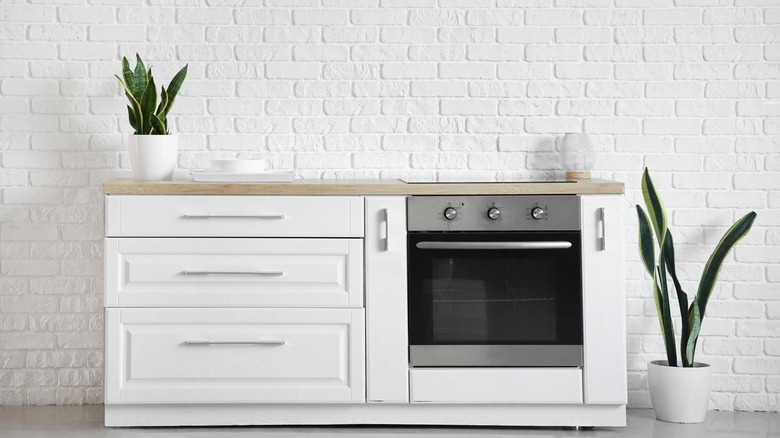11 Genius Tricks To Save Money On Electricity While Using Your Oven
Are you wondering what's the real reason your electric bill is through the roof? On average, Americans eke out approximately $152 on their monthly electric bill (according to saveonenergy), with searing inflation thinning pockets further. Such trends have incentivized some households to experiment with time-based electricity programs, wherein you shift your usage to off-peak hours and get lower bills. Others have resorted to measures like unplugging electric appliances when not in use or switching to LEDs. However, there is room for more — just take a hard look at the metallic box sitting snugly in your kitchen, aka the electric oven.
Our kitchens hold immense scope for energy optimization. Chances are you already resort to habits like chopping food into small sizes and using lids on dishes — both actions reduce the amount of heat needed to cook your food, thereby reducing the use of electricity. During summers, you might even ditch your oven altogether for the outdoor grill and have a barbecue party. But there is much more you can do to save money on electricity while using your oven, as we will elaborate below.
1. Preheat only when necessary
While you might've been conditioned into thinking that the oven isn't ready for use until it's done pre-heating, it isn't always so. In actuality, plenty of dishes can do without this practice, as can last night's leftovers if you're thinking of transforming them into a new dish. But even when pre-heating is essential, ensure you're around the oven to place the dish in as soon as the timer is about to go off. This can go a long way in reducing bills, particularly when cumulated over the long run. Making use of the convection setting helps, too.
2. Ensure the door seal is intact
Do you know what it feels like when your home's weatherstripping cracks? Because that's exactly what working with an oven whose door seal has come loose feels like. Heat can escape from a poorly insulated oven, raising your energy usage (and electric bills) exponentially. In fact, if you haven't been maintaining your oven at all — for instance, haven't changed the fan even though it's in dire need of replacement — you're doing yourself and your pocket a huge disservice. So, up your maintenance game and keep the heat where it belongs — inside.
3. Keep your oven clean
Cleaning your oven is probably not your favorite chore. The hardened grease, the food residue, and the stuck-on grime can seem formidable. But here's the kicker: A clean oven is an efficient one and is your gateway to utility savings. Dirt buildup prevents even heat distribution, translating to high energy usage and longer cooking times. Heat is also wasted on burning old food splatters, but placing aluminum foil on the oven floor to catch those splatters may disrupt heat distribution. Clean the oven thorougly, including the parts of an oven that everyone forgets to clean, particularly the door seal.
4. Prepare multiple dishes simultaneously
If you've ever had to cook a big meal for a family gathering (hello, flashbacks of constantly turning the oven on and off), you know how time-consuming the job can get. But you can simplify things and save energy by cooking different dishes that require similar temperatures at the same time. Choosing the right pan size is equally important to use only the energy necessary. Now, obviously, you don't want your apple pie to reek of garlic bread, so planning the combinations is key. Use the multiple rack levels to your advantage; the lower utility bills will be well worth the effort.
5. Turn off the oven before time
Once your oven is hot, it stays so for a while. So why not use the residual heat to your advantage? Rather than letting the oven run on full blast until your dish is fully cooked, turn it off about 10 minutes before the expected cooking time. However, make this call on a case-by-case basis, as some dishes may require the full cook time at the same temperature. If you need to reheat leftovers, place them in the still-warm oven instead of using the microwave.
6. Avoid opening the oven door unnecessarily
The urge to check on your culinary creation every now and then can be hard to resist. But if you're serious about saving on your electricity bills, it's time to practice patience — it's a virtue, after all. Opening the oven even once can cause the temperature to go down by 25 degrees Fahrenheit. Just imagine the effect that multiple rounds of oven-opening will have on your utility bills. To prevent your oven from working overtime to regain lost heat, learn to trust the timer or peep through the glass for a quick check. Alternatively, use a meat thermometer so that you can see the food's temperature without having to open the door.
7. Defrost in the refrigerator, not in the oven
We get it. Managing the plethora of curveballs that life throws your way can be immensely stressful. So, it's no wonder you forgot to defrost the chicken sitting solid in your freezer an hour away from dinnertime. Now, you could potentially use the oven to help you out but know full well you'll be wasting lots of energy defrosting that way. Instead, plan early, and move the frozen items and any leftovers to the fridge ahead of time (the day before or first thing in the morning should work). Or, use your microwave's defrost function; it will consume far less energy.
8. Invest in energy-efficient appliances
A sure-shot way to save money on electricity is to replace your current oven with a more energy-efficient model, particularly if it's on its last legs. EnergyStar labels will give you a head start on which oven to choose. But you must pay also attention to the oven size. Despite being energy-efficient, larger appliances will consume more energy compared to their smaller counterparts. If a smaller oven works for you, you might want to go with that. You may also want to look for self-cleaning features, as appliances with these features are often better insulated.
9. Switch to more energy-efficient appliances
Full-sized ovens are great, but they aren't the best tool for every cooking job, especially when you look at them from the vantage point of "energy consumption." For instance, a convection oven is better if all you really need to do is reheat last night's meal. That's because it utilizes, at most, half of the energy necessary to power its bigger counterpart. The same rules apply to toaster ovens. Using a portable electric pan or microwave oven can be a substantial money saver when heating small portion sizes.
10. Unplug the oven when not in use
This next tip won't work for everyone, but if you only use your oven occasionally, unplug it the rest of the time. Plugged in appliances use electricity, even when they're not turned on. According to the U.S. Department of Energy, items and appliances on "standby" power eat up anywhere from 5-10% of home energy use. You could spend up to $100 per year powering items that aren't even turned on. Unless you're whipping up meals more often than not, consider unplugging your oven.
11. Use glass or ceramic baking dishes
Instead of metal bakeware, glass baking dishes can be your new best friend. Yes, you can use them to cook anything from casseroles to roasting meat, but this material is very well suited for energy savings. Since glass, as well as its pretty ceramic equivalent, conducts and retains heat for longer, you can afford to lower your oven's temperature by around 25 degrees Fahrenheit when cooking in it. As a result, your oven works less, your food still cooks evenly, and your bills lower.











